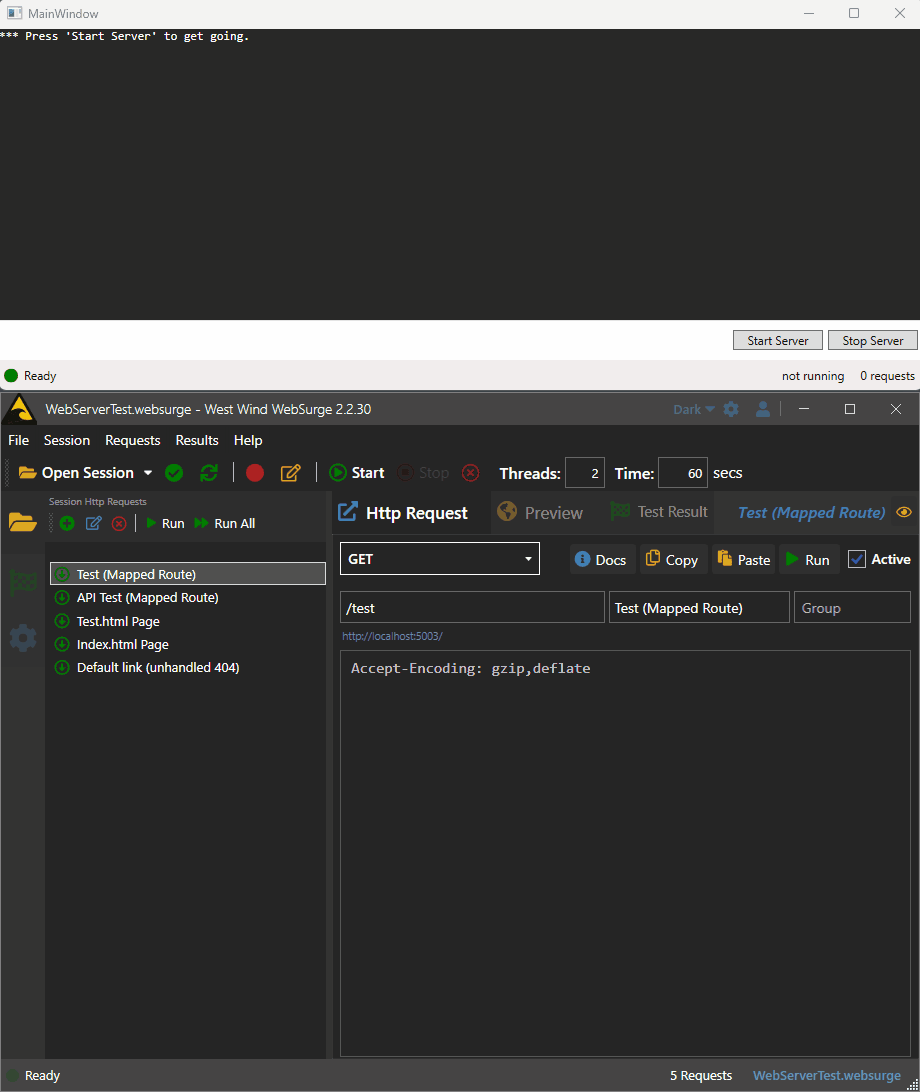This is a sample that demonstrates hosting ASP.NET in a non-primary Web application using the simplest thing possible.
Currently there's no NuGet package, so you have to include a project reference to the Westwind.AspNetCore.HostedWebServer project into your own solution, or directly use the source files. The library is self-contained in a single HosteAspnetWebServer.cs file so it should be easy to integrate into your own projects.
If you decide to include the library in your own code, you'll need to add a framework reference for the ASP.NET Runtime into your project:
<ItemGroup>
<FrameworkReference Include="Microsoft.AspNetCore.App" />
</ItemGroup>If you decide to use the project as reference it'll include that. Regardless of which way you are accessing this functionality:
Note
ASP.NET Runtime Files are required!
In order to use the ASP.NET Hosting components you need to have the ASP.NET Runtime installed or alternately build a self-contained application that will include all the required runtime files.
Potentially this is an additional install beyond say a Desktop Runtime installation that adds additional distribution size to your application.
The following is a simple example of setting up hostable ASP.NET Server instance in a WPF form and displaying requests in a text block.
Here's the implementation in this WPF form:
public MainWindow()
{
InitializeComponent();
InitializeWebServer();
...
}
private void InitializeWebServer()
{
Server = new HostedAspNetWebServer();
// set up routes/mappings or generic handling (fallback)
Server.OnMapRequests = (app) =>
{
app.MapGet("/test", async ctx =>
{
ctx.Response.StatusCode = 200;
ctx.Response.ContentType = "text/html";
await ctx.Response.WriteAsync($"<html><body><h1>Hello Test Request! {DateTime.Now.ToString()}</h1></body></html>");
await ctx.Response.CompleteAsync();
});
app.MapGet("/api/test", async ctx =>
{
ctx.Response.StatusCode = 200;
ctx.Response.ContentType = "application/json";
await ctx.Response.WriteAsJsonAsync(new { Message = "What's up doc?", Time = DateTime.UtcNow });
await ctx.Response.CompleteAsync();
});
app.MapFallback(async ctx =>
{
// You can also use this fallback to generically handle requests
// based on the incoming ctx.Request.Path
// In this case I just return a 404 error
// pick up path and manually parse/serve
string path = ctx.Request.Path;
string verb = ctx.Request.Method;
ctx.Response.StatusCode = 404;
ctx.Response.ContentType = "text/html";
await ctx.Response.WriteAsync($"<html><body><h1>Invalid Resource - Try again, Punk!</h1></body></html>");
await ctx.Response.CompleteAsync();
});
};
// Optionally Intercept Request Start/Completed for logging or UI
Server.OnRequestCompleted = (ctx, ts) =>
{
// Request comes in on non-ui thread!
Dispatcher.Invoke(() =>
{
var method = ctx.Request.Method.PadRight(8);
var path = ctx.Request.Path.ToString();
var query = ctx.Request.QueryString.ToString();
if (!string.IsNullOrEmpty(query))
path += query;
var status = ctx.Response.StatusCode;
var text = method + path.PadRight(94) +
" (" + status + ") " +
ts.TotalMilliseconds.ToString("n3") + "ms";
Model.AddRequestLine(text);
Model.RequestCount++;
});
};
}The above configures the server but doesn't start it. You can start it by using:
private async void Button_Start_Click(object sender, RoutedEventArgs e)
{
Statusbar.ShowStatusSuccess("Server started.");
Server.LaunchAsync(
"http://localhost:5003",
System.IO.Path.GetFullPath("./wwwroot")
).FireAndForget(); // async - don't wait
Model.RequestText = "*** Web Server started.";
Model.ServerStatus = "server is running";
}You pass in two things:
-
One or more launch Urls
Like an ASP.NET Core application you can specify the host and port on which the server should be started. You can provide multple semi-colon seperated urls forhttp://andhttps://urls. -
Static File Resource Path (optional)
If you want to serve static files from a local folder you can specify a folder from which files are served. If you don't provide a path, no local resources will be served otherwise the specified folder is mapped for static file handling.
Once the server is running it continues to run in the background until stopped.
To Stop the server:
private async void Button_Stop_Click(object sender, RoutedEventArgs e)
{
await Server.Stop();
Statusbar.ShowStatusSuccess("Server stopped.");
Model.ServerStatus = "server is stopped";
Model.RequestText = "*** Web Server is stopped. Click Start Server to run.";
}Note if you want to use https:// urls you need to ensure that certificates are installed and configured for the specified ports or - if you can use the .NET SDK you can use dotnet dev-cert https -t to configure and trust the local dotnet certificate.
There's currently no support to explicitly specify certificates, so you have to use the host OS to provide the certificate and port mappings.
